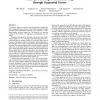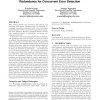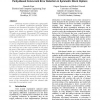112 search results - page 5 / 23 » Concurrent Error Detection in S-boxes |
ASPLOS
2011
ACM
12 years 11 months ago
2011
ACM
Concurrency bugs are caused by non-deterministic interleavings between shared memory accesses. Their effects propagate through data and control dependences until they cause softwa...
IEEEPACT
2006
IEEE
14 years 1 months ago
2006
IEEE
With reducing feature size, increasing chip capacity, and increasing clock speed, microprocessors are becoming increasingly susceptible to transient (soft) errors. Redundant multi...
ITC
2000
IEEE
13 years 12 months ago
2000
IEEE
Concurrent error detection (CED) techniques (based on hardware duplication, parity codes, etc.) are widely used to enhance system dependability. All CED techniques introduce some ...
HPCA
2006
IEEE
14 years 7 months ago
2006
IEEE
With reducing feature size, increasing chip capacity, and increasing clock speed, microprocessors are becoming increasingly susceptible to transient (soft) errors. Redundant multi...
ITC
2003
IEEE
14 years 23 days ago
2003
IEEE
Deliberate injection of faults into cryptographic devices is an effective cryptanalysis technique against symmetric and asymmetric encryption. We will describe a general concurren...



